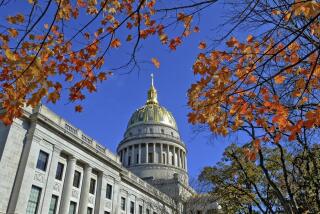‘Light at the end of the tunnel’ for West Virginia water crisis
West Virginians saw signs of hope Sunday even as 300,000 people spent a fourth day under orders not to use their tap water after a chemical spill.
“I believe we’re at a point where we see light at the end of the tunnel,” Gov. Earl Ray Tomblin said. Water samples had shown positive signs that traces of a coal-cleaning chemical were slowly fading from the supply for nine counties, he said.
There was still no timeline on when residents could use their water again, however, forcing residents and businesses to get creative on how they could safely cook, wash their hands and wash their clothes.
In Charleston, restaurants with proper safety plans and the tentative approval of the county health manager were beginning to reopen. Stores that had run out of bottled water had restocked, receiving emergency deliveries from surrounding states.
The city’s three Charleston Area Medical Center hospitals were expected to resume scheduled medical procedures on Monday after receiving trucked-in water. Schools were expected to reopen by Tuesday.
“It will be my expectation that most businesses will be open tomorrow,” Tomblin told reporters on Sunday.
Area churches and other facilities unaffected by the tainted water offered showers for residents who had gone days without bathing.
“I had a person [from Charleston] that was deaf come in and was writing down on a piece of paper that he would like to shower,” said Jeannie Henson, the manager on duty at the Pullman Plaza Hotel in Huntington, which was unaffected by the chemical spill. “And the desk clerk here wrote back, ‘Yes, we have rooms where you can shower.’ Yes, it was very touching. He had his family with him.”
The hotel, about 50 miles west of the capital, had set aside a floor of rooms for affected West Virginians, and families had been coming in for showers all day, Henson told the Los Angeles Times.
“We’re doing all we can,” said Henson, whose daughter in Charleston planned to come by Henson’s house to do laundry.
At the Tri-County YMCA in Scott Depot -- about 20 miles west of Charleston -- there was a two-hour wait for showers.
An employee told The Times that the facility was hooked up to a different water supply from the one that had been contaminated by a coal-cleaning chemical, which leaked into the Elk River on Thursday.
Ten people have been hospitalized and 169 more treated for possible exposure to 4-methylcyclohexane methanol, the colorless liquid that leaked out of a one-inch hole in a storage tank sitting along the river, state officials said Sunday.
The leak was discovered after government officials responded to a complaint about the chemical’s smell Thursday morning, state environmental officials said.
The chemical slipped into the river about a mile and a half upstream from a water treatment plant, forcing officials to scramble to learn about an obscure chemical whose effects on humans were not well known.
On Sunday, Tomblin criticized Freedom Industries, the chemical company, for not being more forthcoming about the chemical after the leak began.
“Most people did not know a whole lot about this particular chemical. … We’ve had to do a lot of research,” Tomblin said, adding, “Perhaps they could have been a little more forthcoming to offer their assistance. … It would have been very helpful.”
Freedom Industries, whose executives have been tight-lipped since a news conference Friday evening, did not respond to a request for comment Sunday evening.
Before the spill, there had not been much oversight of the facility, state officials said. Because the Freedom Industries facility stored the chemicals but didn’t process them, state environmental officials weren’t responsible for inspecting the tanks. And because the chemical was not classified as extremely dangerous, the company was not subject to stricter government regulation.
State officials contacted the Centers for Disease Control for guidance, and said the agency told them that the water could be considered safe for human use when there was only one part per million of the chemical in the water.
On Sunday, officials at Tomblin’s news conference said they had completed two tests on the water treatment plant that had been initially contaminated and found zero parts per million both times.
Officials said they were moving forward with plans on telling residents how to flush their homes’ water systems, which would have to be done zone by zone. The governor continued to urge patience, however.
“Things are looking right; they’re trending in the right direction,” Tomblin said. But, he added, “Please don’t jump ahead. ... It’s important for people to wait until all tests have been done.”
More to Read
Sign up for Essential California
The most important California stories and recommendations in your inbox every morning.
You may occasionally receive promotional content from the Los Angeles Times.











